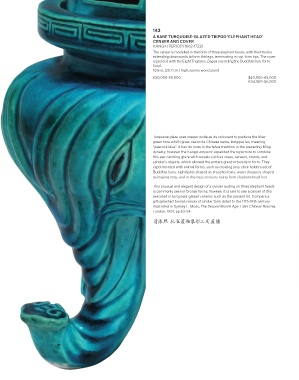Page 166 - Christie's Fine Chiense Works of Art November 2018 London
P. 166
143
A RARE TURQUOISE-GLAZED TRIPOD ‘ELEPHANT HEAD’
CENSER AND COVER
KANGXI PERIOD (1662-1722)
The censer is modelled in the form of three elephant heads, with their trunks
extending downwards to form the legs, terminating in ruyi-form tips. The cover
is pierced with the Eight Trigrams, Bagua encircling the Buddhist lion-form
fnial.
10Ω in. (26.7 cm.) high, nanmu wood stand
£30,000-50,000 $40,000-65,000
€34,000-56,000
Turquoise glaze uses copper oxide as its colourant to produce the blue-
green tone which gives rise to its Chinese name, kongque lan, meaning
“peacock blue”. It has its roots in the fahua tradition in the preceding Ming
dynasty, however the Kangxi emperor expanded the repertoire to combine
this eye-catching glaze with vessels such as vases, censers, stands, and
scholar’s objects, which allowed the potters great virtuosity in form. They
experimented with animal forms, such as creating joss-stick holders out of
Buddhist lions, nightlights shaped as crouched cats, water droppers shaped
as leaping carp, and in this case, censers rising from elephant-head feet.
This unusual and elegant design of a censer resting on three elephant heads
is commonly seen in bronze forms, however it is rare to see a censer of this
executed in turquoise-glazed ceramic such as the present lot. Compare a
gilt-splashed bronze censer of similar form dated to the 17th-18th century
illustrated in Sydney L. Moss, The Second Bronze Age: Later Chinese Bronzes,
London, 1991, pp.53-54.
清康熙 孔雀藍釉象形三足蓋爐

